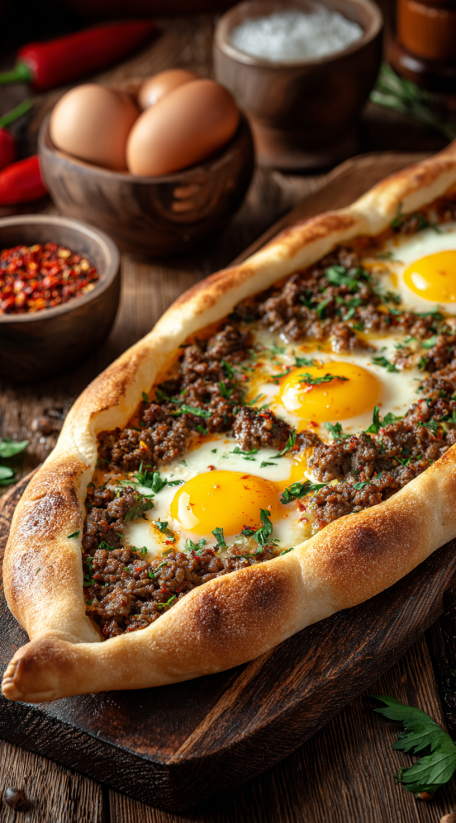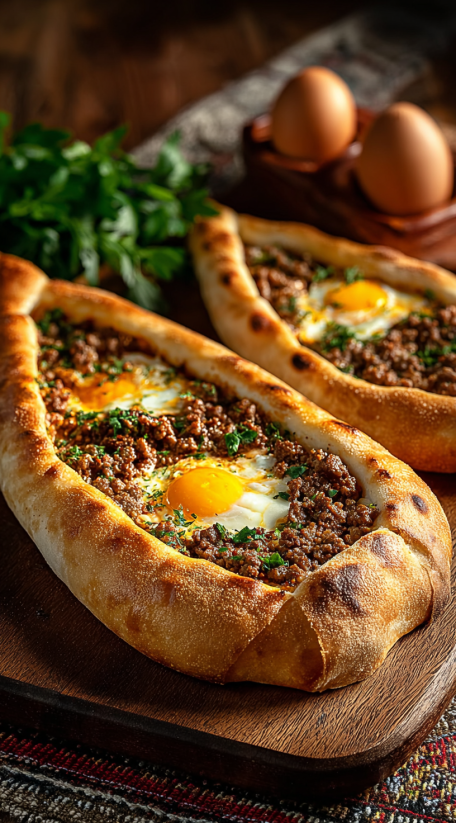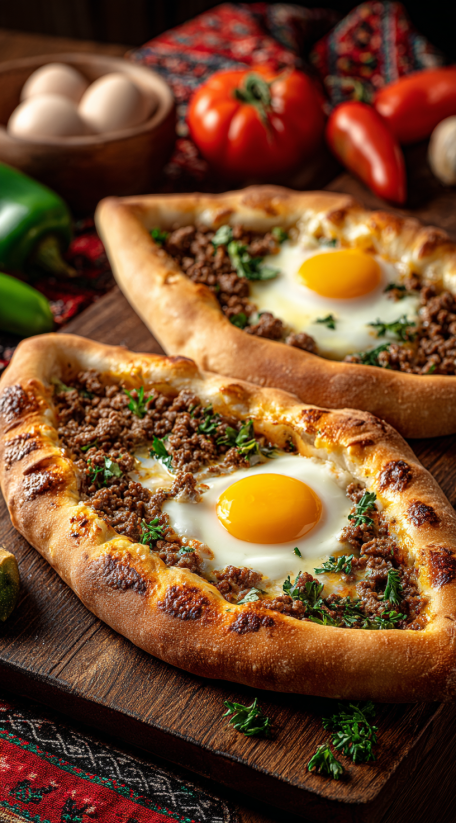 Bookmark
Bookmark
Turkish Pide is a classic comfort food that brings together the fragrant spices of Anatolia and the satisfying chew of fresh-baked bread. Each bite is a blend of rich lamb, sweet vegetables, and just a touch of golden crust—the kind of recipe I make when I want to bring a taste of Turkey to my table. Whether you keep it traditional or try one of the many variations, this pide always disappears fast in my house.
I remember the first time I shaped the pide into that signature boat. It felt like making edible art and made dinner extra special.
Ingredients
- Double zero flour: gives the bread its signature smooth texture and makes shaping easy. Choose Italian double zero for best results
- Dried yeast: helps the dough rise light and airy. Look for yeast with a fresh, neutral scent not bitter or musty
- Salt: brings out the flavors of both bread and filling. Fine sea salt works best for even mixing
- Honey: adds mild sweetness and helps activate the yeast. Use real honey for richer flavor
- Warm water: creates a dough that is soft but not sticky. Use water that feels just warm to the touch not hot
- Olive oil: guarantees a tender crumb in the dough and adds richness to the filling. Go for extra virgin olive oil with a fruity aroma
- Mozzarella (optional): brings a creamy layer. Look for low-moisture mozzarella for optimal melt
- Lamb mince: offers bold savory flavor that absorbs spices beautifully. Freshly ground lamb is ideal
- Onion: adds a gentle sweetness and moisture to the lamb filling
- Red pepper: provides mild sweetness and color. Choose firm peppers without blemishes
- Tomatoes: give a touch of acidity for balance. Use vine-ripened tomatoes for best flavor
- Cumin powder: supplies warm earthy notes and blends into the lamb mixture
- Coriander powder: adds a bright aroma and a little citrus punch
- Turmeric: colors the filling golden and brings mild bitterness. Fresh ground turmeric has the brightest color
Step-by-Step Instructions
- Make the Dough:
- In a large bowl combine double zero flour dried yeast and salt. Dissolve honey in warm water then slowly pour into the flour mixture. Mix and knead the dough for about ten minutes pressing with the heel of your hand and folding the dough over itself. When it feels elastic and a bit shiny add olive oil and knead five more minutes. The dough should be smooth and soft not sticky. Cover with a damp towel and let it rise in a warm place for about one hour until doubled in size.
- Prepare the Filling:
- Heat olive oil in a skillet over medium heat. Add finely chopped onions and red peppers. Stir constantly and cook until onions are translucent and peppers are soft about six minutes. Add the lamb mince breaking it up with a spoon. Cook until no pink remains. Stir in diced tomatoes cumin coriander and turmeric. Cook the mixture for ten minutes stirring occasionally until it thickens and becomes fragrant. Take off the heat and let cool slightly.
- Shape and Assemble:
- Preheat your oven to 220 degrees Celsius. Punch down the risen dough and turn it onto a floured surface. Divide into even pieces and roll each into an oval about half a centimeter thick. Place the ovals onto a lined baking sheet. Spoon a generous amount of lamb filling onto each oval leaving the edges free. Fold and pinch the long sides to create a boat shape and gently twist the ends to keep everything in place.
- Bake:
- If adding mozzarella sprinkle cheese on the filling just before baking. Transfer the trays to the preheated oven. Bake for fifteen to eighteen minutes until the crust is golden brown and the filling bubbles gently. Remove and let cool a minute before slicing and serving warm.
 Bookmark
Bookmark
My favorite touch is wrapping the dough just so around a cheesy filling. It reminds me of watching Turkish bakers shape dozens at lightning speed when I first visited Istanbul. Sometimes we make this together as a family sharing stories while working the dough.
Storage Tips
Pide keeps best wrapped in foil or stored in an airtight container in the fridge for up to three days. Warm it up in a hot oven for five to seven minutes to refresh the crust without drying it out. You can also freeze baked pide for up to three months. Just let it cool completely wrap tightly and reheat straight from frozen in the oven for a quick meal.
Ingredient Substitutions
If you cannot find lamb mince ground beef or a beef and lamb mix works well though the flavor will be slightly less earthy. For a vegetarian pide use chopped mushrooms and extra vegetables in place of the meat. Feta or kashar cheese is a great swap for mozzarella. For a gluten free version try your favorite pizza crust mix and shape smaller ovals for easier handling.
 Bookmark
Bookmark
Serving Suggestions
Serve pide hot from the oven with a fresh chopped salad of tomatoes cucumber and parsley dressed with lemon and olive oil. It is also delicious with a side of garlicky yogurt dip or pickled vegetables for something tangy. A traditional Turkish ayran drink or a light lentil soup makes it a complete and nourishing meal for lunch or dinner.
Cultural and Historical Context
Pide is deeply woven into the culture of Turkey and the Anatolian region in particular. Each town puts its own spin on fillings and shapes. It was originally a meal for travelers and has become a street food favorite as well as a family staple. Watching a pide baker slide boat shaped breads into a wood fired oven in a busy Turkish bakery is an experience to remember and making it at home lets you bring that little bit of history to your own kitchen.
Frequently Asked Questions About Recipes
- → What makes Turkish Pide unique compared to pizza?
Turkish Pide is shaped like a boat, which helps keep its toppings in place while baking. Its crust is thinner and airier, offering both a crispy edge and a chewy center. Distinct spice blends and unique fillings, such as spiced lamb or pastirma, set it apart from Italian pizza.
- → Which fillings are most traditional for Turkish Pide?
Classic fillings include seasoned lamb or beef mince, tomatoes, onions, and regional spice mixes like cumin and coriander. Cheese varieties, eggs, vegetables, and pastirma are also popular, offering diverse flavor profiles.
- → How do you serve Turkish Pide for best flavor?
Serve hot from the oven with sides like chopped salads, creamy yogurt dips, or tangy pickled vegetables. Pairing with Ayran, a Turkish yogurt drink, is traditional and balances the savory richness of the Pide.
- → Can Turkish Pide be made vegetarian or vegan?
Absolutely! Vegetarian versions often use fillings like spinach and feta, while vegan options feature mushrooms, bell peppers, olives, and plant-based cheese or spreads.
- → What is the secret to a perfect flatbread base?
Use high-quality 00 flour, allow enough time for the dough to rise, and bake at a high temperature. Olive oil adds tenderness, while honey helps activate the yeast for an airy structure.
